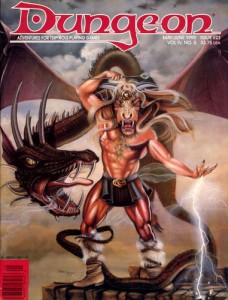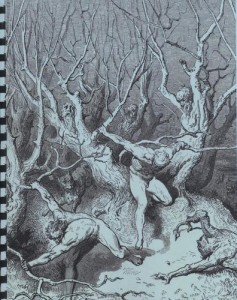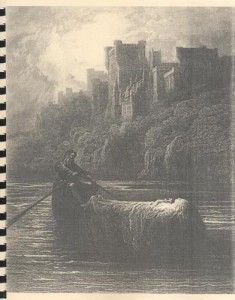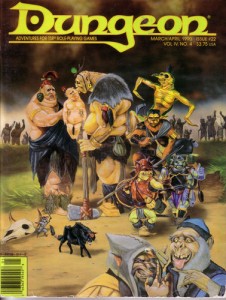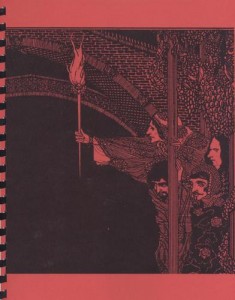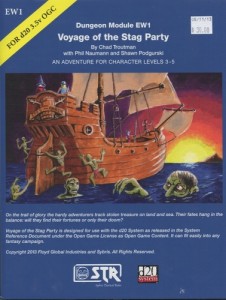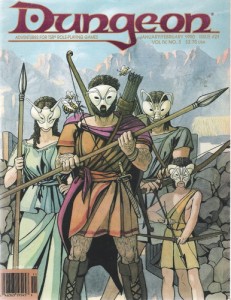A rare “non-review” post! One of my three-ish a year. 🙂
Fair Warning: I don’t follow this shit so I don’t know the background here, or even if this is all common knowledge.
I played in the actual “Sundering” event at Winter Fantasy. It turns out Mystra wasn’t TOTALLY dead. The second half of the BI had the players attacking Cyric’s prison and “Sundering” his throne, which, along with killing Cyric (the spellplague was caused by it leaking from his head) and some intervention by Lathander, has brought Mystra back. She did a new weave and “the worlds are moving apart again” whatever that means. And thus Living Forgotten Realms ends and the whole Spellplague and 4e madness (god of madness, get it?) is over.
The whole “sundering and connected events/players impact the world” thing appears to be taking the Living Forgotten Realms model. People play adventures, send in their results, and the plot/further adventures are connected to those results.
WYC Playback:
I was at the con Friday-Sunday. The con seemed smaller. The convention center LCD’s said “DDXP/Winter Fantasy”, but I thought DDXP moved to GenCon for this year? There were 3 vendors, 2 guys selling game stuff and 1 selling T-shirts. There was an Artimis set up (didn’t play here but have before, lots of fun!) and the GenCon boardgame library.
The boardgame library generally had 7-10 tables going, and during ‘off’ times had as many games going as there were RPG tables. Pathfinder had a couple of tables, but I believe they suffered from a lack of Judges. There’s didn’t seem to ever be more than 2 tables of Next running. The Saturday Battle Interactive had 17-20 tables, which again seemed a bit smaller. I don’t recall there being any lectures/seminars/etc as there had in years pat, which I suspect is a by-product of it not being DDXP anymore.
The only game we could get Friday night was Pathfinder. I’ve only played once before. A mostly linear adventure to rescue some Dwarven diplomats from the religious fundie neighboring kingdom. The DM was one of the better ones (main Pathfinder organizer at the con, I think) during the weekend. The final scene was more open-ended than the rest of the adventure, taking place in a mostly empty, and largish, roadside inn. The battle, once engaged, took place throughout the inn as we escaped. That portion felt more open and “free flowing” than the rest of the adventure scenes. The adventure was full of bullshit names that did NOT roll off the tongue. It was comical how bad that part was. Nice & realistic though, of you’re in to that sort of thing.
Saturday morning we played Living Forgotten Realms 4e Core 6-1 “Behind Obould’s Lines.” War was coming and our 1st level dudes went behind the Orc lines. We convinced one tribe of to abandon the high king of the orcs because they had too many trade ties to the humans. We convinced the second set hat the high king wasn’t blood thirsty enough. We then destroyed some siege gear and killed a Netherese diplomatic convoy, before engaging in a lame skill contest to escape. This adventure suffered a lot from solo-itis. Many parts were focused on 1 or 2 people, leaving everyone else sitting out and waiting. And waiting. The first two sections were diplomacy, which of course meant the guy with the highest diplomacy did all the talking. And he didn’t want to roll play but just roll the dice. But still took forever. Then there was a “prove yourself” section which involved a 2 on 2 combat. This being 4e that took an hour. The rest of us would be punished if we interfered, so we were all sitting around doing nothing. Bad bad adventure design. The “destroy the siege engines” was a skill challenge. The “kill the diplomatic convoy” was an ambush turkey shoot, which was fun to be on the “shooting” side for once. It was also, essentially, the only group party thing we did. We then did THREE skill challenge sections to escape the orcs … which was all very thrown together at the end and felt really out of place. The DM was one of the core con staff, I think, and he wasn’t deviating much from the script. The allowed actions were the allowed actions. I did not approve of his style. At the end of the adventure we were bumped to Level 11 to allow us to play in the Battle Interactive, as a part of the adventure.
The BI is the BI, all 11 hours of it. If you don’t think of it as D&D then it will be one of the most fun things you will do at a con. Basically, you are an army of adventurers engaged in some kind of joint activity. So all of the tables, 20 or so at this con, were all doing about the same thing and our results impacted each other and the future encounters during the game. In this one the Netherese were attacking the last free city (Cormyr? Suthil? SOmething like that) and we were all the special forces. I guess the whole year of Living ZForgotten Realms has been leading up to this moment. It starts with forming up a group, and a group of guys from Columbus needed wizards (my son and I were playing the pregen 11th level wizards from the LFR website) so they asked us to join them. I always feel bad, and grateful, when this happens, since we NOT hardcore 4e at all and the Winter Fantasy crowd generally are. So we’re going to suck the group down AND you get to ply with a kid. How fun! But I’m also obviously grateful that they invited us to play with them and didn’t seem upset that we sucked.
Anyway, main DM gets up on a table and describes what’s going on. There’s evil dragons overhead, swooping down on the city! But then flights of gold, silver, and metallic dragons swoop out over the east and crash in to them in combat, and the battle rages overhead while we’re doing things on the ground. A giant floating sky city comes in to attack and then out of nowhere another small city appears and crashes in to it in the air and then after a bit they both crash to the ground! Then the united orc tribes rise up over a hill, all “Rider of Rohan” style, and the Orc king gives a mighty battle cry and yells who’s with me?! as he turns to face his nations and they charge down the hill! all 50 orcs behind him cheer and follow him in to the valley of death … his remaining tribal nations having deserted him! During this completely cheesy stuff various people are cheering, the ones who went on those adventures. And when he got to the orcs my son and I cheered. That was us; we did that and it had an effect on the battle! It sound stupid, and anyone who has read my reviews knows I can be a cynical asshat, but even now, writing this up two days later, I get a little choked up over the pre-battle action descriptions of dragon armies in battle and sky cities fighting each other and the orc armies.
On to the main BI action. They have a map of the city up on a wall via a projector with six adventure sites. Over the next four hours our table will try to complete as many of the missions as possible, just as the other tables will, and each time we do a green dot appears on the site. Enough green dots and that mission is ‘won’ and the battle changes a bit from there on. We started by attacking cult hideouts, then moved on to one of the corrupted treant groves, and then moved on to a strategic ruined tower, and so on. As you are doing yours others are doing the same or different ones, and the map on the wall is updating, allowing you to better choose the next mission your table goes on. It’s a lot of fun. At one point living cloudkill moved in to the city and some tables abandoned their missions to go help 1/6th of the city each. Again, it’s kind of cheesy to think of an army of adventurers but also lots of fun imagining all of these Special Forces tables undergoing missions while the main battle rages. They do a good job of making you feel special, and part of the larger effort with your actions having consequences, without it being the lame “you, Bob, single-handedly are the star and saved the universe.” It’s a very nice shared experience. The second 4-hour section had us attacking the prison of the mad god Cyric to sunder his throne and bring back Mystra so she could rework the weave. These didn’t seem as fun as the first section of missions, but at the end you kill Cyric, restore Mytra, etc etc etc. Oh, and for killing a god you get bumped to 21. So my son and I started as rutabega farmers that morning, went to the wizards tower to help with the war effort, were given some magic training and sent off to war (our backstory we made up), leveling up through 11 and on to 21 by the end of the day. Kind of a cute series of events.  Lots of fun, and just 11 hours of tactical miniatures battles using 4e, with nothing resembling the kind of D&D I like to play … but still an AWESOME con experience. I think we died something like 12 times among the 6 of us, with 2 complete TPK’s. We got res’d and they marked that mission as a ‘fail’ on map. It doesn’t have to make sense, it’s fun.
Lots of fun, and just 11 hours of tactical miniatures battles using 4e, with nothing resembling the kind of D&D I like to play … but still an AWESOME con experience. I think we died something like 12 times among the 6 of us, with 2 complete TPK’s. We got res’d and they marked that mission as a ‘fail’ on map. It doesn’t have to make sense, it’s fun. 
I fucked up our tickets he next morning. We were supposed to play Castle Greyhawk from 8-12 and then Isle of Woe from 12-4, both 5e events. I looked right at the tickets and said “were playing isle of woe from 8-12.” and we did … and then couldn’t play Greyhawk from 12-4 because it was full. I was supposed to help tear down the boardgame library, filling in as a favor to someone who broke an ankle, but they pushed the time back to 3pm and I wasn’t about to wait around for 3 hours, so we drove home after I got a replacement. At the end of Woe a different judge made the mistake of asking me my opinion. There is STILL too much bullshit in 5e, IMO. Every time someone says something like “oh wait, you get an extra +blah because of …” or someone is looking at their Char Sheet instead of at the DM, then the the designer has failed. That is CLEARLY the 4e way, and the latest 5e rules have some of that also, although not as much. The judge announced it was free-flowing i 5e and then spent a lot of time judging the game like it was 4e (although not as hard core) with lots of rule look ups, etc. Maybe that was just because it was an intro game, IDK. I tried to make a point, since it was dungeon, of not taking combat spells but rather utility spells. There were not as many utility spells (to be “creative” with) as I would have liked. I don’t know what’s going on. If people are in Pathfinder/3e/4e mode and can’t look at the situation without looking at the char sheet and rules, or what.
On the way home my son (13) said something like “Im a little sad; 4e was MY first D&D and my favorite because of that.”
It was a good weekend, and my comments should not be taken as otherwise.
My test of a good DM is my equipment list. If I can use my Big Blanket and Chicken, shovel, crowbar, or sock full of CP in an adventure then the DM is a good one. If I can’t then the DM is a rules-bound tool. This isn’t hard and fast, but the DM’s reaction to creative play tells a lot about them, I think. I threw my blanket over a “sticks to snakes” square in pathfinder, and fed my chicken to a river serpent in pathfinder. That was a good DM. I didn’t even try anything in the BI, and the Obould’s lines DM wasn’t having any of my creative nonsense. The Woe guy let me get away with my Wand of Doors (from Fight On! Magazine) but was a little too combat focused. The dungeon was stuffed with nonsense creatures who wanted to nothing but fight. It felt a lot more like a 4e delve than a 1e dungeon. But there WERE puzzle rooms and weird effects and shit. I think I detected a “treasure parcel” which set off my rage-O-meter. I’ve had better DM’s at Winter Fantasy than the 5e guy, but he wasn’t in full on 4e mode. Gotta remember, Winter Fantasy attracts the hardest of the hardcore rules RPGA players.

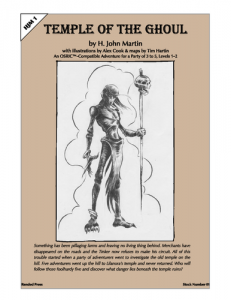
 Lots of fun, and just 11 hours of tactical miniatures battles using 4e, with nothing resembling the kind of D&D I like to play … but still an AWESOME con experience. I think we died something like 12 times among the 6 of us, with 2 complete TPK’s. We got res’d and they marked that mission as a ‘fail’ on map. It doesn’t have to make sense, it’s fun.
Lots of fun, and just 11 hours of tactical miniatures battles using 4e, with nothing resembling the kind of D&D I like to play … but still an AWESOME con experience. I think we died something like 12 times among the 6 of us, with 2 complete TPK’s. We got res’d and they marked that mission as a ‘fail’ on map. It doesn’t have to make sense, it’s fun. 